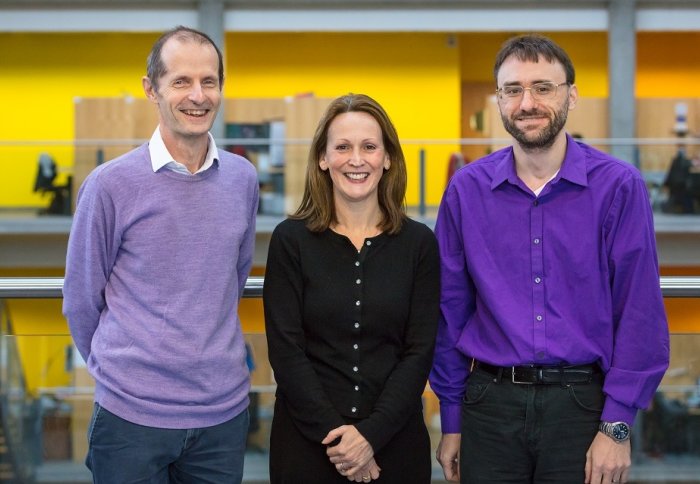Imperial scientists present vaccine revolution to world leaders at WEF in Davos

Three Imperial scientists presented their ideas on next generation vaccines to global leaders at the World Economic Forum in Davos, Switzerland.
The academics from Imperial’s Network for Vaccine Research, joined leaders from the G20 and other countries, CEOs of multinationals, members of international organisations and other scientists at the WEF Annual Meeting.
The Imperial group lead an IdeasLab session titled ‘Developing a Vaccine Revolution’.

President Alice Gast, who introduced the vaccine experts, wrote for the World Economic Forum this week about how they are 'working to reverse the inverse care law as they advance vaccine technology'.
President Gast also chaired the Global University Leaders Forum (GULF) and spoke on a panel with President of Colombia Iván Duque Márquez and global CEOs, including Marc Benioff of Salesforce to update on the Centres for the Fourth Industrial Revolution Network.

President Gast said: “We really do need global multi stakeholder collaboration to make a difference and that is what the centre for the 4ID brings.
"It’s incumbent on all of us to work together to pursue technology for the benefit of society.
"AI is changing fundamental basic research. It's enhancing our ability to design molecules in chemistry, making it possible to understand our microbiome, develop technologies for people to use in medicine, health, surgeries and tackle climate change.
"We need to make sure we are pursuing fundamental research that benefits society and at the same time educate our students and the population."
The President of Colombia announced that Medellín will host a centre for the Fourth Industrial Revolution, focusing on AI, Internet of Things, and Blockchain, in 2019.
Imperial's Dr Robin Carhart-Harris, Head of Psychedelic Research at the Department of Medicine, was also at Davos to discuss his research into psychedelic medicine.
Agile response to outbreaks and Disease X

Professor Robin Shattock, Head of Mucosal Infection and Immunity within the Department of Medicine, is working on the manufacturing of RNA vaccines to create quicker and more accessible responsiveness to outbreaks of known pathogens - such as flu, and unknown pathogens, called Disease X.
His team is improving the production system of vaccines to quickly provide tens of thousands of new vaccine doses within weeks of a new threat being identified. Currently, vaccines can take 10 years or more to develop.
We need to completely reimagine the way vaccines are being produced and approved Professor Robin Shattock Head of Mucosal Infection and Immunity
Synthetic RNA vaccines – which harness the body’s own cell machinery to make an antigen rather than injecting the antigen directly – take only weeks to produce and may offer the easiest route for global product consistency.
This approach is already being successfully used in cancer. This technology provides the ability to manufacture anywhere in the world and Professor Shattock is prototyping it in the Future Vaccine Manufacturing Research Hub.
Professor Shattock said: “In a pandemic situation, for every month delay, there is a potential for five million fatalities, that’s equivalent of losing a city the size of Rome or Singapore every month. We need to completely reimagine the way vaccines are being produced and approved.”
Alternative approach to prevent outbreaks

Professor Wendy Barclay, Medical Research Chair in Virology at the Department of Medicine, is aiming to understand whether there is a potential to develop disease control through new measures of animal protection, exploring transgenic animals and how they could impact vaccine spread.
The source of all influenza is wild water birds, like ducks and geese. The avian virus can cross into farmed animals, chickens and pigs, which are a stepping stone for the virus to jump into humans.

People exposed to infected chickens can catch ‘bird flu’, which is often fatal.
Professor Barclay believes that by preventing influenza virus crossing from wild birds into chickens, we would stop the next pandemic at source.
Working with the Roslin Institute, Professor Barclay is using CRISPR technology - a way to precisely alter the genome of a species to introduce beneficial new traits - to develop chickens that are totally resistant to infection by influenza virus.
Professor Barclay said: “With our idea to generate farmed animals that cannot be infected by influenza viruses we aim to bring global health security by stopping influenza pandemics from emerging.”
Heat-stable vaccines for use in remote and low-income settings

Professor Jason Hallett, Professor of Sustainable Chemical technology at the Department of Chemical Engineering, is working on thermal stabilisation of vaccines allowing them to exist in room temperature without destroying their efficacy.
Replacing the standard vaccines with heat-stable versions would lower costs and enable them to be used in challenging conditions, such as in regions where the cold-chain that current vaccines require, cannot be maintained.
Up to 80% of the cost of vaccinating a person is due to cold storage at negative 50 degrees.
This temperature has to be maintained when shipping vaccines across the world.
The cold chain is needed to stop vaccines from being destroyed by heat and water.
This gives rise to a shelf life at room temperature – a maximum amount of time vaccines can be safely stored.
Professor Hallett has designed salts that could act like water and protect the vaccine structure even when hot.
Professor Hallett said: “If we could eliminate the need for cold storage, then we could produce vaccines anywhere in the world. We could ship them and store them indefinitely. This really matters when you don’t live in a major city.”

The theme for this year’s WEF Annual Meeting is Globalization 4.0: Shaping a Global Architecture in the Age of the Fourth Industrial Revolution.
MAKING CONNECTIONS IN VACCINE RESEARCH
-
Photo Credits (at WEF): World Economic Forum. All rights reserved.
Photo Credits (Others): Imperial College London
Article text (excluding photos or graphics) © Imperial College London.
Photos and graphics subject to third party copyright used with permission or © Imperial College London.
Reporter
Stephen Johns
Communications Division